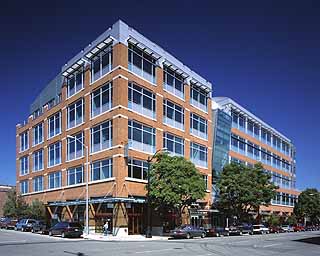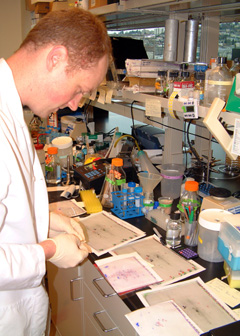
Surveys
DJC.COM
July 28, 2005
Green buildings can spark economic growth
Vulcan Inc.

Hazlehurst
|
Environmentally sustainable projects representing every sector of the real estate industry have been designed and constructed with growing frequency around the world. Local and state governments across the country, including Washington and the city of Seattle, have implemented construction requirements and environmental standards as green building quickly reaches critical mass. The U.S. Green Building Council's Leadership in Energy and Environmental Design (LEED) rating system has also been pivotal in raising awareness of sustainability in the building industry.
At the same time, private developers have become increasingly savvy in adopting state-of-the-art sustainable approaches.
Numerous studies have validated the significant return on investment from sustainable projects and high-performance buildings that use resource-efficient measures and boost employee productivity and health in the process.

Photos courtesy Vulcan Inc.
The 112,000-square-foot SBRI Building in South Lake Union is Seattle’s first LEED-certified speculative building.
|
Pleasant views, fresh air and natural daylight, the use of nontoxic building materials and the ability to control personal climate can contribute to considerable savings by reducing absenteeism and helping to retain employees.
It is estimated that just a 1 percent increase in productivity will cover an employer's annual energy costs.
New sustainability
Beyond the cost savings and environmental benefits, developers are beginning to recognize that sustainable projects can help breathe new life into communities and serve as catalysts for economic growth. This natural shift in thinking will ultimately help realize a broader vision to create more environmentally sustainable, community-oriented and economically dynamic regions.
A prominent example of how this forward-thinking vision is taking shape in the Puget Sound region is the Seattle Biomedical Research Institute (SBRI) Building in South Lake Union. Developed by joint venture partners Vulcan, SBRI and Harbor Properties, the 112,000-square-foot SBRI Building is a state-of-the-art, five-story biomedical research and office facility with ground-level retail.
Home to nearly 200 researchers and other employees, SBRI is the largest nonprofit research institute in the U.S. that focuses solely on infectious disease research. Researchers from Children's Hospital and Regional Medical Center also occupy the building, sharing common meeting areas with SBRI.
The SBRI Building was conceived with sustainability and environmental awareness in mind, and was one of the nation's first commercial-sector projects to be evaluated under LEED's Core and Shell pilot program. It earned a silver LEED rating in February 2005, becoming Seattle's first LEED-certified speculative building.

Institutes such as SBRI draw workers that tend to embrace susainable values.
|
Sustainability measures at the SBRI Building include:
Attracting the creative class
With South Lake Union poised to become a major growth center and world-class life sciences research hub — the city forecasts that the neighborhood will add 20,000 jobs and 10,000 residents in the next 20 years — there is a prime opportunity for visionary employers such as SBRI to help cultivate a new model for urban, sustainable development.
Developing a cutting-edge research facility that is environmentally conscious not only provides the ideal backdrop to make breakthrough discoveries, it also helps draw top talent who tend to be attracted to work environments that embrace sustainable values. SBRI's presence in the South Lake Union neighborhood has helped serve as the tipping point to foster a vibrant, highly collaborative biotech community at the forefront of driving a new economic engine for the region.
Renewed sense of community
The SBRI Building demonstrates that sustainable projects can effectively use design elements to help create a new neighborhood connection and a more active, engaged community. For example, ground-level retail was included in order to animate the streetscape and create a community-friendly atmosphere. The corner storefront is finished with reclaimed redwood and an operable wall for open-air seating, creating a sense of pedestrian intimacy and visual appeal on the sidewalk.
SBRI's BioQuest science gallery on the first floor serves as a window into the life-saving science that is conducted upstairs and features artistic exhibits to educate visitors about the importance of improving global health — quite literally a community living room for life sciences. The gallery can be viewed by passersby through over-sized windows.
The benefits of adopting sustainable development practices stretch far beyond the environmental advantages, helping to promote economic vitality and the overall well-being of a community. Supporting the growing momentum around sustainable building development ultimately rests in the hands of policy makers, citizens, developers, employers and urban visionaries.
Hamilton Hazlehurst is a real estate development manager for Vulcan Inc., which is developing nearly 60 acres in Seattle's South Lake Union neighborhood.
Other Stories:
- Saving salmon: Now the hard work begins
- Whitewater parks move into the mainstream
- Momentum is building to reduce global warming
- Turning waste into environmental, social good
- Let the sunshine in, efficiently
- The hazards of flicking on a light switch
- A road map for Columbia Basin's future
- Canada: A lesson in salmon recovery planning
- Better mapping may change development rules
- What makes a green consumer?
- Farmers, government team up to save fish
- Seattle law firms end their paper chase
- Food industry puts energy efficiency on the menu
- A solution to Hood Canal's lurking pollution?
- Stretching Washington's water supply
- Seattle finds gold with sustainable strategies
Copyright ©2009 Seattle Daily Journal and DJC.COM.
Comments? Questions? Contact us.